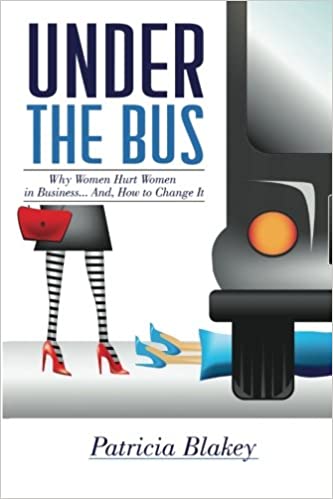Getting run over emotionally by a metaphorical “Bus” from a boss, colleague, friend, or family member can be completely deflating to our personage and to our spirit. So what exactly does it mean to be thrown under the bus?
I recently heard the term stated three times in one day. In each instance, the person using this phrase was indicating that they had the power to throw someone “under the bus”, meaning they could remove another person from the control or power in a given situation. As I heard this term being used, I understood it to be in a playful manner. However, listening to the stories told by others with real-life experiences, throwing someone “under the bus” can have devastating consequences with lasting trauma and deep emotional symptoms.
Social behavior can often have intense consequences. What if it happens to you? What if this phenomenon has had intense consequences for you? How do you recover?
Perhaps this is already hitting home with your life experiences. The current global impact of a Pandemic caused many people to have emotional losses beyond their control. Indeed, they were ‘thrown under the bus”. Loss of family and friends, businesses, livelihoods, careers, educational goals, and opportunities were all direct results of the chaos of the Covid-19 Pandemic. It’s been a deep emotional blow to the internal spirit for many, giving way to treating anxiety, depression, loss of self-esteem, devolution of goals, and sadness. Many won’t have the ability to muster up the energy to try again as a consequence.
Ask an Expert
So how can we pull ourselves back from the emotional deflation and unexpected shock that has altered the course of life? Specifically, how can we pull ourselves out from “under the bus”?
For some answers, I spoke to the Author Patricia Blakey, an expert on the subject. Her book “Under the Bus, Why Women Hurt Women in Business and How to Change” (available on Amazon or at Barnes & Noble) explains how she survived being “thrown under the bus” at the height of her career.

Blakey journaled about the crushing event and her emotional feelings. In a state of anger and grief, she sought advice from her family and friends. While working through the classic steps of grief, she realized that the common act of throwing someone “under the bus” is actually a phenomenon experienced by many. As a result, she turned her journaling into a book in order to help others who have experienced this same thing. “You can always use your pain and suffering and how you recovered from it to help others,” Blakey insisted.
Blakey explained how going to book signings and talking to attendees made her feel. “The gratitude from so many people for writing this book lifted me, and the book gives them a way to love themselves again- to get confidence back, to be whole.” She encourages her readers to share her message. “People have taken my book and given it to a family member who then shares it with someone who is “under the bus”. It has been a healing experience for many people.”
A Common Experience
A list of books with themes relating to being “thrown under the bus” validates this familiar social phenomenon at a variety of individual levels. Some people report physical trauma coinciding with mental trauma and anguish that causes physical pain, eating disorders, sleeplessness, and anti-social behavior. As Blakey writes in her book, there are many ways to work through this traumatic experience. Meditation, yoga, journaling, or speaking to a therapist are a few of the tools needed to get to the different levels of recovery. Let’s take a look at these remedies.
1. Meditation
As a practicing Alternative Medical Doctor and long-time Ayurvedic and Yoga Instructor, I tend to agree with many of Blakey’s suggestions. Starting with meditation, I highly recommend meditating to gain back your spirit and trust as you pull yourself out from “under the bus”. However, not all people can achieve quick results with this method due to the nature of their trauma. For those that suffer from PTSD, the mind is in such a traumatic state that it can’t hold still long enough to concentrate. There is a tendency to over-examine events, question one’s judgment, or possess the inability to read a situation or intention of another.
Recommended Practice
Meditation will grow your mind back to confidence over time although it is not easy to do when you are in trauma and emotional pain. My suggestion is to start with a color and sit for two minutes with that color in front of you (use a scarf or tie for simplicity). Sit in a quiet, comfortable place. Close your eyes and visualize the color. As you focus only on the color, breath in through both nostrils of the nose, and then breath back out through the mouth in a loud sigh.
If you practice this for two weeks, you will master two minutes of your life gaining back control. You will own this power of breath. In the next two weeks increase it to 4 minutes. As you progress over time, you can start breathing in through the nose and out through the nose. If you take the time to own this breath, you will have let the anxiety that is present leave the mind and body. You will regain control of your spirit.
I like to see my patients become centered quickly, get their minds focused, and gain trust for one’s own self-judgment. I say this because people blame themselves for these truly unforeseen and uncontrollable “under the bus” situations. There are remedies, however, to tone down PTSD reactions as well. One natural product line that I encourage my patients to use is Dr. Bach’s Flower Essence (TM).
2. Natural Tinctures
As previously noted, there are levels to the “under the bus” phenomenon and Dr. Bach’s Flower Essence (TM) has various products to suit most people’s emotional needs.
Dr. Bach’s Rescue Remedy (TM)
The Rescue Remedy (TM) is a quick delivery with fast-acting relief of fear, anxiety, grief, anger, and shock to the emotional system. It will calm down the circling of the mind, remove fight or flight triggers, balance endocrine reaction to fear, reverse the loss of appetite, improve sleep, and reduce body shaking, crying, and the sense of being isolated. It comes in a spray or tincture and goes under the tongue.
You can expect to feel better within 10 minutes or less. The calmness that can occur is amazing. Use as needed every few hours with multiple doses every 15 minutes for intense emotional reactions until you feel grounded.
Dr. Bach’s Flower Essence Gentian (TM)
For more devasting life events like a major income setback or unexpected divorce, a second level of “under the bus” treatment can be found with Dr. Bach’s Flower Essence Gentian (TM). Hailed as the best remedy to “Accept Setbacks” by Dr. Bach himself, Gentian addresses the emotional symptoms of serious setbacks, a broken life path, or delay and hindrance to hopes and dreams. In the situation of Patricia Blakey losing her career, Gentian would be a good remedy to assist in her recovery.
Dr. Bach’s Flower Essence Gorse (TM)
For the person who has much doubt, becomes disheartened with their situation, appears hopeless, becomes despondent to move forward, feels great discouragement and depression, has no energy, and is content to live in a state of sadness, Dr. Bach offers Gorse- a “have hope” remedy. This is a third-level product that goes much deeper into the mind, almost scaring the very spirit of a person.
Selecting these natural remedies, one or all, will deliver an emotional lift. Using between 1⁄2 or full dropper, applied under the tongue, between three to six doses a day will provide relief of emotional symptoms caused by the feeling of being thrown “under the bus”.
A Triage To Begin Healing
The Homeopathic rule of healing suggests working from the inside out. I recommend taking Gorse, the third level for resolving the deepest of symptoms and emotional pain; then Gentian, a second level remedy to aid in recognizing and planning a new path; and finally Rescue Remedy (TM) when it’s time to step outside the house and embrace the world again though you still carry fear.
These are all self-help recommendations, but if you are currently working with a therapist and taking anti-anxiety meds or antidepressants, the Dr. Bach remedies can still be used in concert without a contraindication. These products are made from flowers that we see and pass every day, and the remedies speak to the body’s spiritual intersection with its immune system. They are effective and safe.
Dr. Bach’s Flower Essences(TM) are sold at most health food stores and can even be found in airport gift shops.
3. Yoga
Yoga, my life calling and my personal tool, is another recommended aid to help move the fight or flight responses out of the body and out of the mind. Yoga helps you to become focused on where you are now and what you feel now.
Virabhadrasana III (Warrior) is the right healing pose to practice because you cannot emotionally goof off or let the mind circle while in this position. Virabhadrasana III is a very strong healer for being “thrown under the bus”. It will strengthen your character and mind, and build back your spirit. Try this at home.
- Get a chair.
- Stand behind the chair with feet and toes pointing toward the chair.
- Lean the body so the belly rests on the back of the chair, or
- Place your hands on the seat of the chair.
- Align your upper body over the chair.
- Lift the right leg up first and parallel with the hips.
- Hold for two minutes (or as long as you can).
- Breathe while you hold, in through both nostrils and out both nostrils.
- As you progress, lift the left arm, parallel with the hips, and reach forward.
- As I teach, there is no wrong way…do the best you can.
- You are now growing stronger.
Finding a new Joy
Trying one or more of these tools, recovery aids, begins the pull out from “under the bus'”. There is no timeline, it may be a long and slow process. There is no promise of a quick recovery, just a promise you will get your spirit back and find hope again.
Lastly, select a mental thought or mantra- a personal honesty in how to move forward or a revelation you will need to embrace. And remember…
- You can never go back to fix it.
- You will have to reinvent yourself.
- The trauma will be replaced with Joy!
Let’s begin to pull you out from under the bus, and find your new joy!


